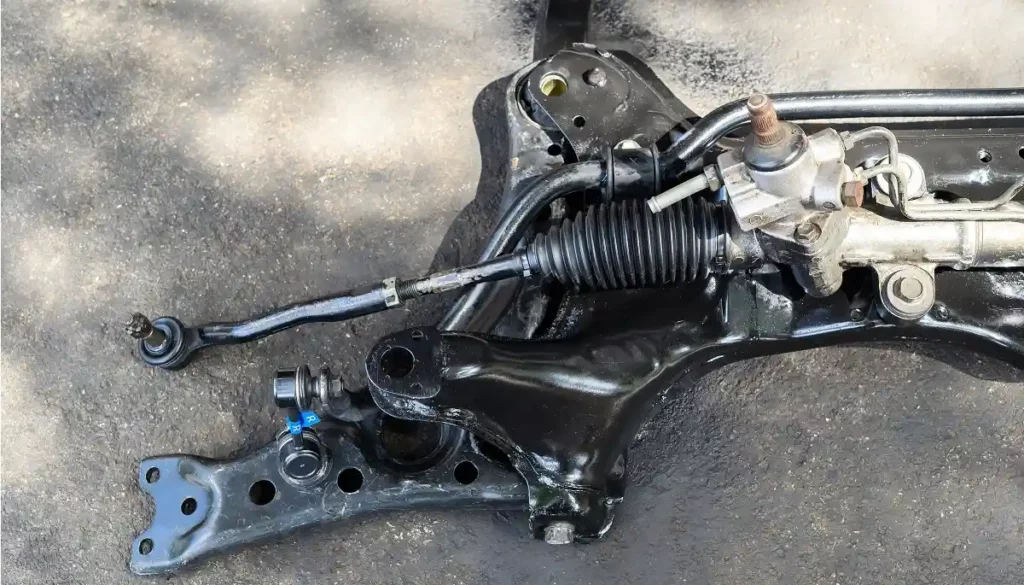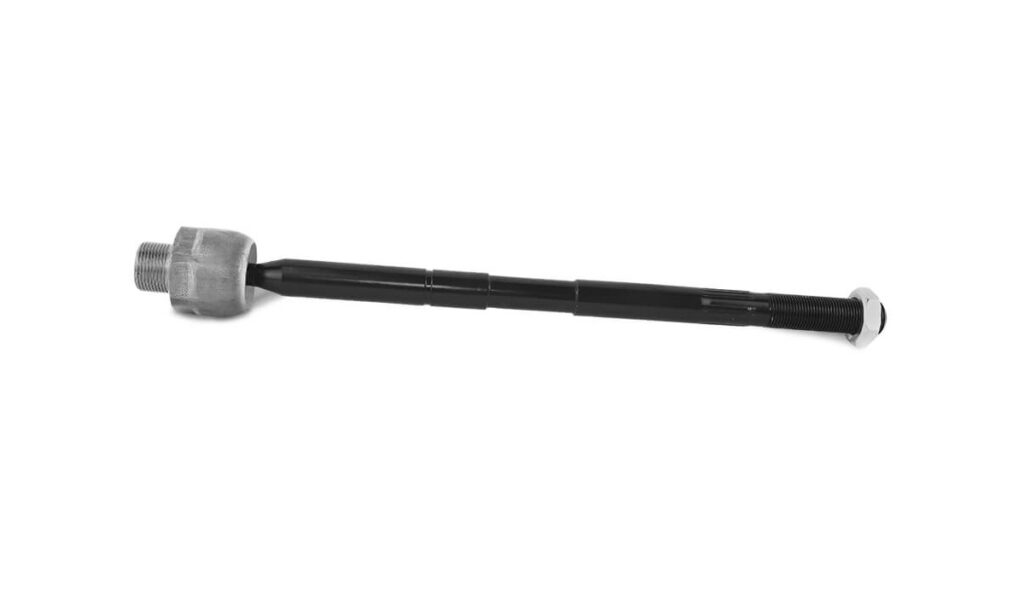Every vehicle consists of a complex network of components that work in harmony to ensure a smooth and safe driving experience. Among these components, the inner tie rods play a crucial role in maintaining steering control. However, like any other part, inner tie rods can fail over time, leading to potential steering issues.
Recognizing the symptoms of inner tie rod failure and diagnosing the problem early on is essential to prevent accidents and expensive repairs. In this guide, we will explore the causes and symptoms associated with inner tie rod failure as well as provide insights into diagnosing this issue.

What Causes Inner Tie Rod Failure?
The inner tie rods, despite their small size, play a critical role in connecting the steering rack to the wheels, enabling precise control over steering movements. However, several factors can contribute to inner tie rod failure, compromising the vehicle’s handling and safety. In this section, we will delve into the common causes behind inner tie rod failure, shedding light on the various factors that can lead to wear, damage, and eventual failure of this important component.
- Wear and Tear — Over time, the constant movement and stress placed on the inner tie rod can lead to wear and tear. The tie rod’s ball joints and sockets can deteriorate, resulting in excessive play and eventual failure. This is why our inner tie rods are designed to withstand prolonged wear and tear, without failing. BISON PERFORMANCE Inner Tie Rods deliver years of reliable use and precise steering.
- Lack of Maintenance — Neglecting regular vehicle maintenance, such as failing to lubricate the tie rod ends or inspecting the boots for damage, can accelerate inner tie rod wear. Insufficient lubrication can cause increased friction and wear, leading to premature failure.
- Contaminated or Damaged Boots — The inner tie rod is protected by rubber or polyurethane boots that keep dirt, debris, and moisture out. If these boots become damaged or torn, contaminants can enter and compromise the inner tie rod’s joints and components. Exposure to moisture can lead to corrosion and accelerated wear.
- Improper Installation — If the inner tie rod is not installed correctly, with improper torquing or inadequate alignment, it can lead to premature failure. Incorrect installation can cause misalignment and excessive stress on the tie rod components, resulting in accelerated wear.
- Accidents or Impact — Collisions or significant impacts, such as hitting a curb or pothole, can damage the inner tie rod. The sudden force can cause bending, misalignment, or internal damage to the tie rod components, leading to failure over time.
- Overloading — Overloading a vehicle beyond its recommended weight limits can place excessive stress on the suspension and steering components, including the inner tie rod. Continuous overloading can lead to accelerated wear and failure.
- Road Conditions — Driving on rough roads, uneven surfaces, or roads with frequent potholes can subject the inner tie rod to increased stress and impact forces. Prolonged exposure to such conditions can contribute to premature wear and failure.
It’s important to note that these causes can vary depending on various factors, such as vehicle type, driving conditions, and maintenance practices. Regular inspections, proper maintenance, and cautious driving can help mitigate the risk of inner tie rod failure.
Get OE quality BISON PERFORMANCE Inner Tie Rods for your car and enjoy a comfortable, precise driving experience!
Symptoms of Inner Tie Rod Failure
When inner tie rods fail, they change the way your vehicle handles and tracks. Depending on the severity of the problem, you could also experience all kinds of vibrations at the steering wheel. Here are the most common symptoms associated with inner tie rod failure.
Uneven Tire Wear
One of the early indicators of inner tie rod failure is uneven tire wear. When the inner tie rod wears out or becomes loose, it can cause the wheels to misalign. As a result, the tires may exhibit uneven wear patterns. Inspect your tires regularly for signs of excessive wear on the inner or outer edges. Uneven wear across tires can indicate a potential inner tie rod failure.
Vibrations and Shaking
If you notice unusual vibrations or shaking in your vehicle’s steering wheel, it could be a sign of inner tie rod failure. The worn-out tie rod may cause excessive play in the steering system, leading to vibrations transmitted through the steering column. Pay attention to any shaking sensations, especially during turns or at higher speeds, and have the issue inspected promptly.
Loose or Imprecise Steering
Inner tie rod failure can result in loose or imprecise steering. As the tie rod deteriorates, it loses its ability to provide stable and precise steering control. You may notice increased play or a vague feeling when turning the steering wheel. This lack of responsiveness and precision can compromise your ability to maneuver the vehicle safely.
Knocking or Clunking Noises
Faulty inner tie rods can produce knocking or clunking noises when you turn the steering wheel. The worn-out joint may cause the tie rod to move excessively, resulting in the noise. If you hear any unusual sounds while steering, especially during turns or when transitioning from side to side, it’s advisable to have your vehicle inspected by a qualified mechanic.
Steering Wheel Off-Center
A misaligned or off-center steering wheel can indicate inner tie rod failure. If the tie rod becomes loose or damaged, it can affect the alignment of the wheels and cause the steering wheel to be off-center even when driving straight. Keep an eye on your steering wheel’s position while driving and note any deviations from the center position.
Diagnosing Inner Tie Rod Failure
To accurately diagnose inner tie rod failure, it is recommended to consult a professional mechanic or automotive technician. However, if you have some knowledge and experience working on vehicles, you can perform a preliminary inspection yourself. Here are a few steps to help you diagnose this issue:
- Visual Inspection — Inspect the inner tie rod boots for signs of damage, such as cracks, tears, or grease leaks. Any visible damage may indicate a failing tie rod.
- Wheel Movement — Raise the vehicle on a jack stand and grasp the tire at the 3 o’clock and 9 o’clock positions. Attempt to wiggle the wheel back and forth. Excessive movement or play could suggest a worn-out inner tie rod.
- Joint Inspection — While the vehicle is still raised, inspect the inner tie rod joint for excessive play. This can be done by applying gentle force in different directions and checking for any noticeable movement or looseness.
How to Fix a Bad Inner Tie Rod?

Fixing inner tie rod issues typically involves replacing the faulty tie rod. It is recommended to consult a professional mechanic or automotive technician for this repair, as it requires specialized tools and knowledge. However, if you have the necessary skills and equipment, you can attempt to replace the inner tie rod yourself. Here is a general guide to fixing inner tie rod issues:
Note: This guide assumes you have already diagnosed the problem and determined that the inner tie rod needs to be replaced.
Gather the necessary tools and materials — You will need a jack and jack stands, a socket wrench set, a tie rod end puller tool, a torque wrench, a new inner tie rod, and any additional hardware provided with the replacement part.
Safety precautions — Ensure that the vehicle is parked on a flat surface and engage the parking brake. Use wheel chocks to prevent the vehicle from rolling. Wear appropriate safety gear, such as gloves and safety glasses, throughout the process.
Raise the vehicle — Use a jack to lift the front of the vehicle off the ground. Place jack stands beneath the appropriate support points to secure the vehicle in an elevated position.
Remove the wheel — Locate the inner tie rod that needs replacement behind the wheel. Loosen the lug nuts, then remove the wheel to access the inner tie rod assembly.
Remove the outer tie rod end — Locate the outer tie rod end attached to the steering knuckle. Remove the cotter pin and loosen the castle nut. Use a tie rod end puller tool to separate the outer tie rod end from the steering knuckle.

Remove the inner tie rod — Locate the inner tie rod connected to the steering rack. Use a wrench or socket to loosen and remove the locking nut securing the inner tie rod to the steering rack. Carefully unscrew the inner tie rod from the steering rack, noting the number of turns required to remove it.
Install the new inner tie rod — Screw the new inner tie rod into the steering rack using the same number of turns noted during removal. Ensure it is tightened securely.
Reattach the outer tie rod end — Thread the outer tie rod end onto the new inner tie rod. Tighten the castle nut and insert a new cotter pin. Follow the manufacturer’s torque specifications for proper tightening.
Reinstall the wheel — Place the wheel back onto the wheel hub and tighten the lug nuts. Lower the vehicle from the jack stands using the jack, and remove the stands.
Test and align — Start the vehicle and test the steering to ensure it functions properly. It is recommended to have a professional perform a wheel alignment to ensure proper alignment after the tie rod replacement.
Remember, this guide provides a general overview of the process, and specific steps may vary depending on the make and model of your vehicle. If you are unsure or uncomfortable with any aspect of the repair, it is best to seek the assistance of a qualified mechanic.
Get Durable Inner Tie Rods, Get BISON PERFORMANCE!
Recognizing the symptoms of inner tie rod failure is crucial for maintaining vehicle safety and preventing potential accidents. If you experience any of the mentioned symptoms, it’s essential that you give your steering system a closer look. Inspect everything mentioned above and remember to use OE quality BISON PERFORMANCE steering components!

